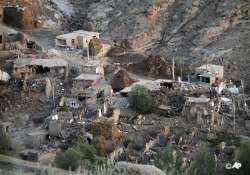Iran raises earthquake death toll to 306
Tehran, Aug 13: Iran Monday raised the death toll from Saturday's twin earthquakes to 306, a day after rescuers called off the search for survivors, state media reported.Heath Minister Marzieh Vahid Dastjerdi told a session

Tehran, Aug 13: Iran Monday raised the death toll from Saturday's twin earthquakes to 306, a day after rescuers called off the search for survivors, state media reported.
Heath Minister Marzieh Vahid Dastjerdi told a session of parliament Monday that the number jumped by about 50 after victims expired in the hospital. More than 3,000 people were injured in the earthquakes, she added in comments broadcast on state radio.
The death toll included some 219 women and children, Dastjerdi said, adding that around 2,000 injured people had been released from hospitals soon after the quake since they had only minor injuries.
Dastjerdi said her ministry has deployed scores of ambulances and medics to the region but still needs helicopters to transfer seriously injured people quickly.
Authorities say old, heavy roofs without frames were largely responsible for the death toll in the rural areas.
Scores of aftershocks have coursed through Iran's mountainous northwest since the 6.4 and 6.3 magnitude quakes hit the region, where some 300,000 people live in an area around 2,300 square miles (6,000 square kilometers) that borders Azerbaijan and Armenia.
The quakes hit the towns of Ahar, Haris and Varzaqan in East Azerbaijan province. At least 12 villages were totally leveled, and 425 others sustained damage ranging from 50 to 80 percent, state TV and news agencies reported.
Many roads and other infrastructure were heavily damaged. State TV showed relief workers distributing tents and helping survivors, mainly in rural areas.
Meanwhile Iran's Red Crescent Society said the country does not need any foreign aid.
Spokesman Pouya Hajian told semiofficial ISNA news agency that the International federation of Red Cross and Red Crescent, UNICEF, Turkey, Taiwan, Singapore, Germany and many embassies in Tehran had offered help but that the Iranian Red Crescent is able to support the quake-stricken areas.
The head of Red Crescent Society of in the quake-struck province also said international aid was not needed.
The ISNA report added that Iran has sent back a rescue team from Turkey that had arrived in the region without advance coordination.
Iran is located on seismic fault lines and is prone to earthquakes. In 2003, some 26,000 people were killed by a 6.6 magnitude quake that flattened the historic southeastern city of Bam.
Heath Minister Marzieh Vahid Dastjerdi told a session of parliament Monday that the number jumped by about 50 after victims expired in the hospital. More than 3,000 people were injured in the earthquakes, she added in comments broadcast on state radio.
The death toll included some 219 women and children, Dastjerdi said, adding that around 2,000 injured people had been released from hospitals soon after the quake since they had only minor injuries.
Dastjerdi said her ministry has deployed scores of ambulances and medics to the region but still needs helicopters to transfer seriously injured people quickly.
Authorities say old, heavy roofs without frames were largely responsible for the death toll in the rural areas.
Scores of aftershocks have coursed through Iran's mountainous northwest since the 6.4 and 6.3 magnitude quakes hit the region, where some 300,000 people live in an area around 2,300 square miles (6,000 square kilometers) that borders Azerbaijan and Armenia.
The quakes hit the towns of Ahar, Haris and Varzaqan in East Azerbaijan province. At least 12 villages were totally leveled, and 425 others sustained damage ranging from 50 to 80 percent, state TV and news agencies reported.
Many roads and other infrastructure were heavily damaged. State TV showed relief workers distributing tents and helping survivors, mainly in rural areas.
Meanwhile Iran's Red Crescent Society said the country does not need any foreign aid.
Spokesman Pouya Hajian told semiofficial ISNA news agency that the International federation of Red Cross and Red Crescent, UNICEF, Turkey, Taiwan, Singapore, Germany and many embassies in Tehran had offered help but that the Iranian Red Crescent is able to support the quake-stricken areas.
The head of Red Crescent Society of in the quake-struck province also said international aid was not needed.
The ISNA report added that Iran has sent back a rescue team from Turkey that had arrived in the region without advance coordination.
Iran is located on seismic fault lines and is prone to earthquakes. In 2003, some 26,000 people were killed by a 6.6 magnitude quake that flattened the historic southeastern city of Bam.